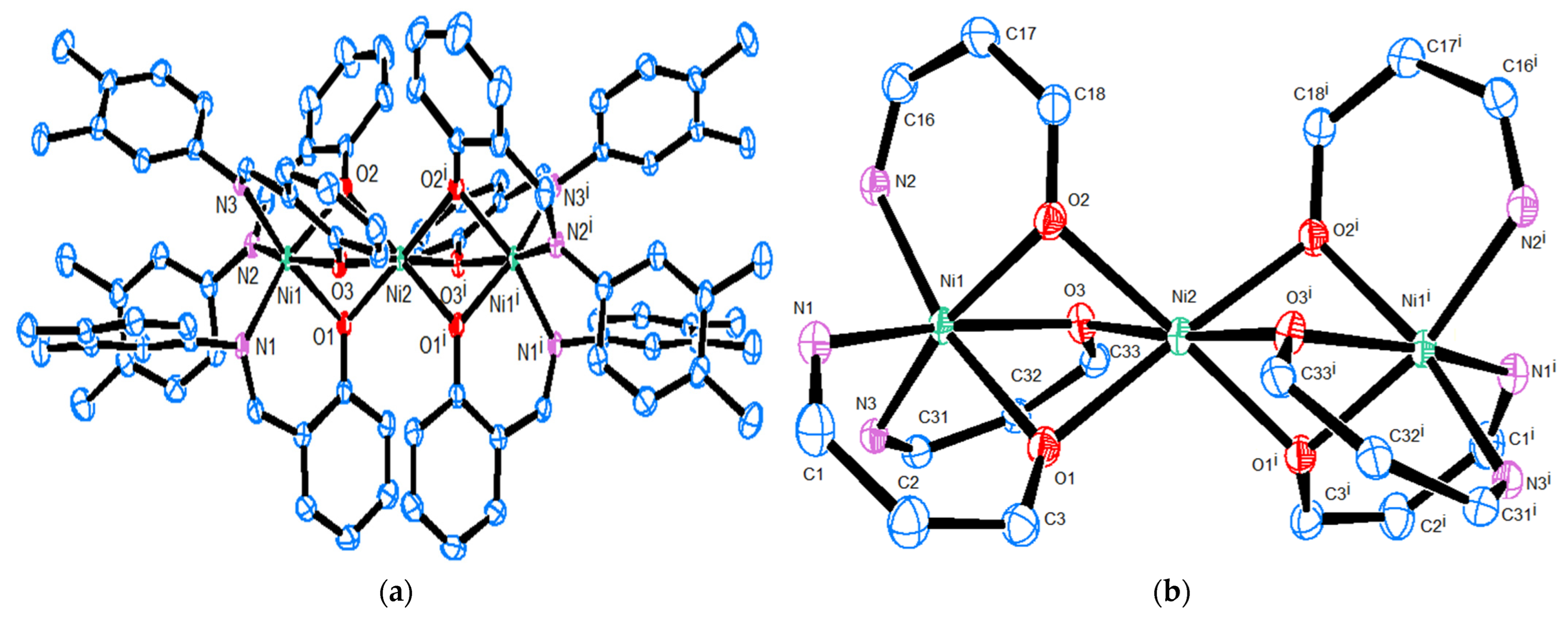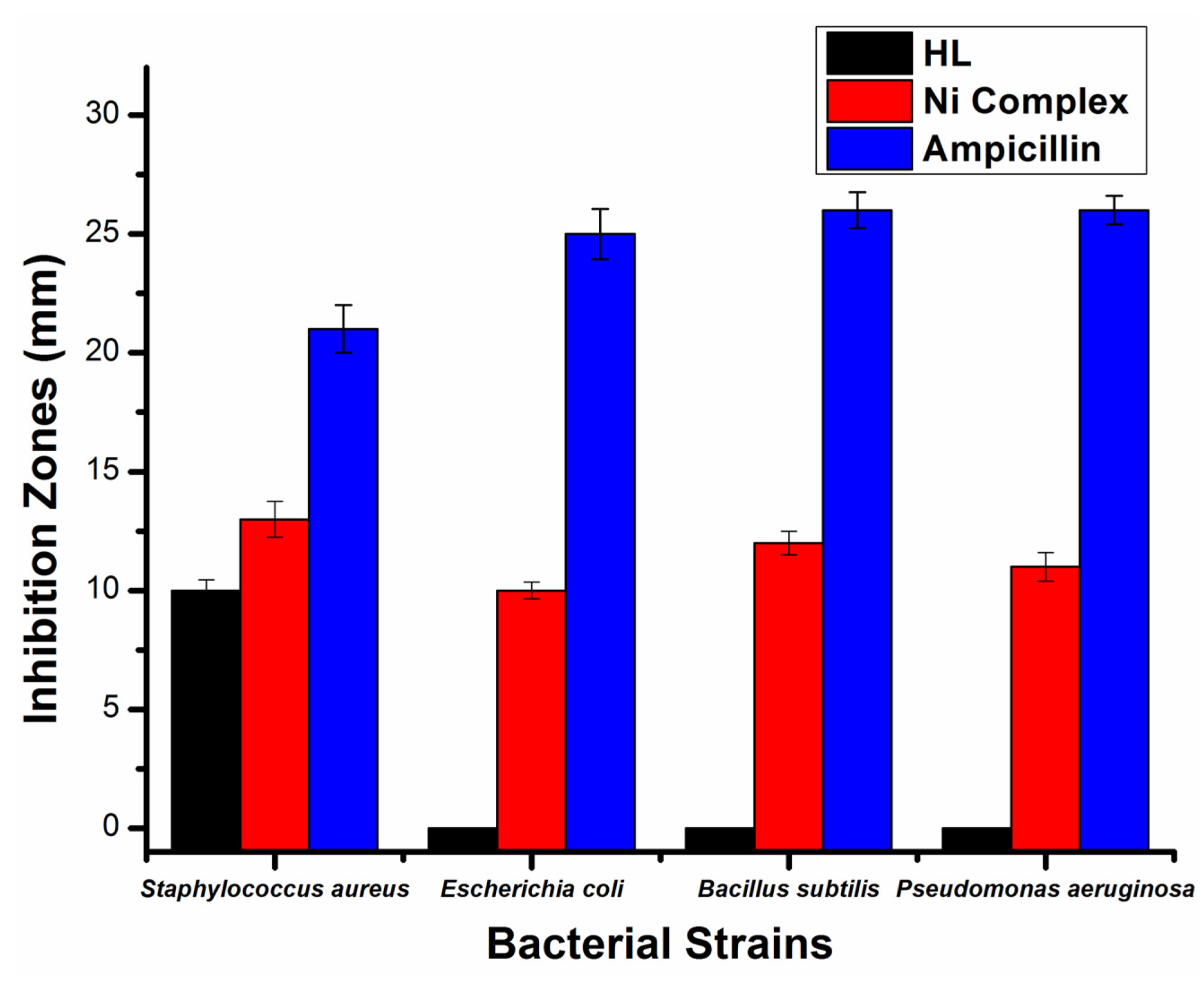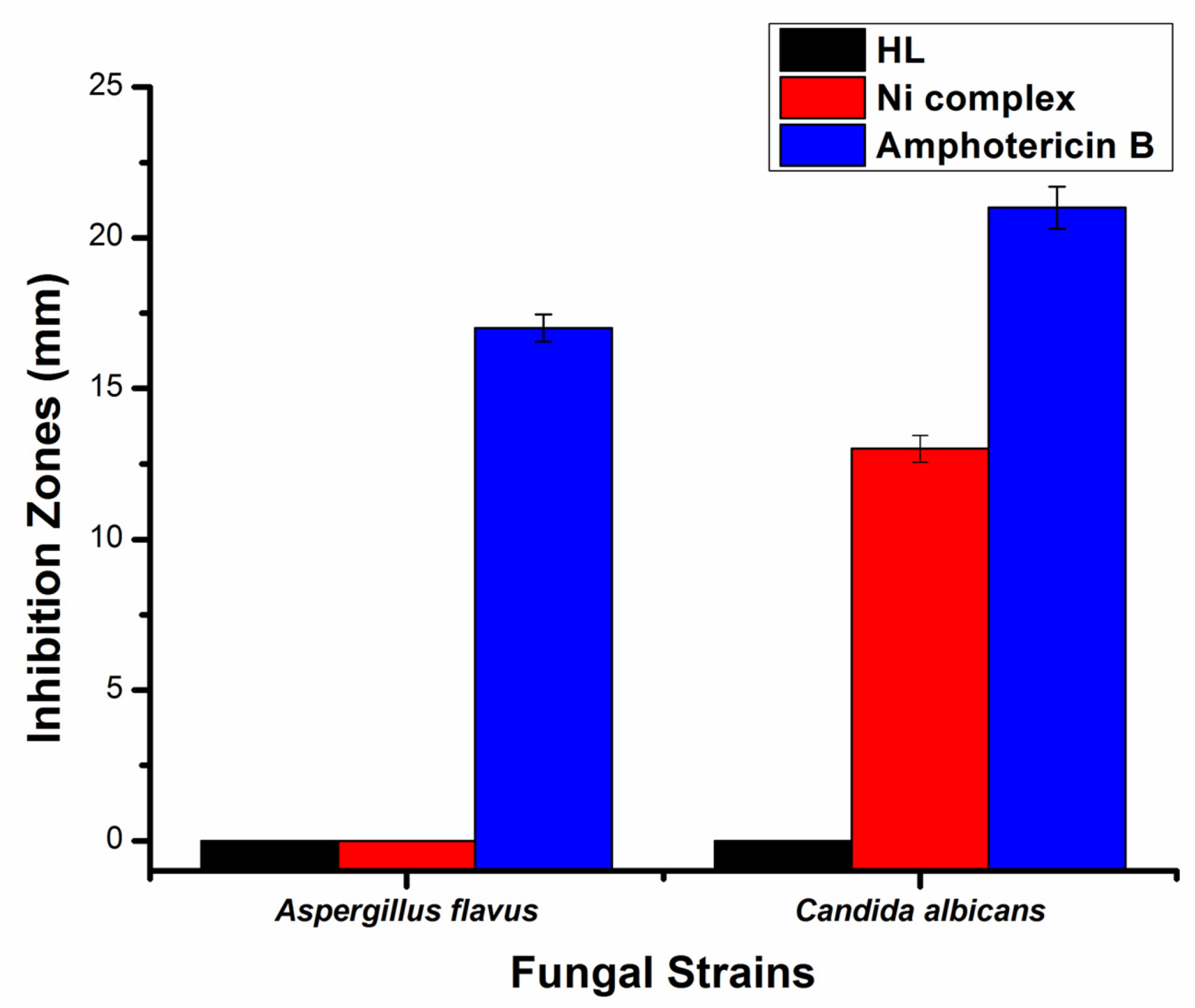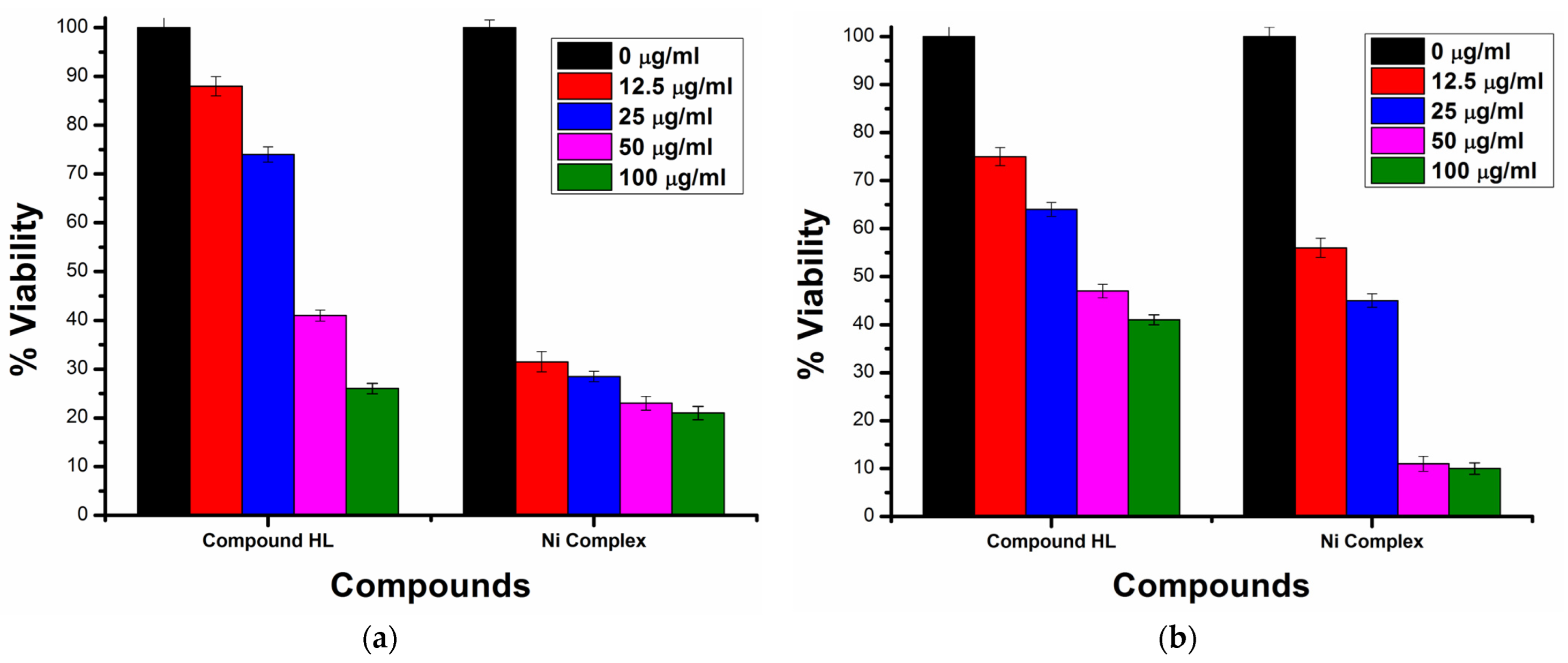A Novel Trinuclear Nickel(II) Salicylaldimine Complex: Synthesis, Structural Characterization, Bioactivity Profile against Bacterial, Fungal and Breast Cancer Cells and Effects on Wheat Germination Indices
Abstract
1. Introduction
2. Materials and Methods
2.1. Chemicals and Instruments
2.2. The Complex Synthesis
2.3. In Vitro Antimicrobial Activity Assay
2.4. Cytotoxic Activity Assay in Cancer and Normal Cells
2.5. Effects on Drought-Sensitive and Drought-Resistive Wheat Cultivars
2.6. Statistical Analysis
3. Results and Discussion
3.1. Formation of the Nickel Complex
3.2. X-ray Diffraction Analysis
3.3. Microbial Inhibition Data
3.4. Cytotoxic Activity Data
3.5. Effects on Drought-Sensitive and Drought-Resistive Wheat Cultivars
4. Conclusions
Author Contributions
Funding
Data Availability Statement
Acknowledgments
Conflicts of Interest
References
- Tidwell, T.T. Hugo (Ugo) Schiff, Schiff bases, and a century of beta-lactam synthesis. Angew. Chem. Int. Ed. 2008, 47, 1016–1020. [Google Scholar] [CrossRef] [PubMed]
- Krishnamoorthy, P.; Sathyadevi, P.; Muthiah, P.T.; Dharmaraj, N. Nickel and cobalt complexes of benzoic acid (2-hydroxy-benzylidene)-hydrazide ligand: Synthesis, structure and comparative in vitro evaluations of biological perspectives. RSC Adv. 2012, 2, 12190–12203. [Google Scholar] [CrossRef]
- Yang, W.; Liu, H.; Du, D. Efficient in situ three-component formation of chiral oxazoline-Schiff base copper(ii) complexes: Towards combinatorial library of chiral catalysts for asymmetric Henry reaction. Org. Biomol. Chem. 2010, 8, 2956–2960. [Google Scholar] [CrossRef] [PubMed]
- Sano, T.; Nishio, Y.; Hamada, Y.; Takahashi, H.; Usuki, T.; Shibata, K. Design of conjugated molecular materials for optoelectronics. J. Mater. Chem. 2000, 10, 157–161. [Google Scholar] [CrossRef]
- Lee, S.A.; You, G.R.; Choi, Y.W.; Jo, H.Y.; Kim, A.R.; Noh, I.; Kim, S.J.; Kim, Y.; Kim, C. A new multifunctional Schiff base as a fluorescence sensor for Al3+ and a colorimetric sensor for CN− in aqueous media: An application to bioimaging. Dalton Trans. 2014, 43, 6650–6659. [Google Scholar] [CrossRef]
- Nayar, C.R.; Ravikumar, R. Review: Second order nonlinearities of Schiff bases derived from salicylaldehyde and their metal complexes. J. Coord. Chem. 2014, 67, 1–16. [Google Scholar] [CrossRef]
- Li, S.; Chen, S.; Lei, S.; Ma, H.; Yu, R.; Liu, D. Investigation on some Schiff bases as HCl corrosion inhibitors for copper. Corros. Sci. 1999, 41, 1273–1287. [Google Scholar] [CrossRef]
- Al Zoubi, W.; Al Mohanna, N. Membrane sensors based on Schiff bases as chelating ionophores-a review. Spectrochim. Acta A Mol. Biomol. Spectrosc. 2014, 132, 854–870. [Google Scholar] [CrossRef]
- Jeevadason, A.W.; Murugavel, K.K.; Neelakantan, M.A. Review on Schiff bases and their metal complexes as organic photovoltaic materials. Renew. Sustain. Energy Rev. 2014, 36, 220–227. [Google Scholar] [CrossRef]
- Nakayama, A.; Hiromura, M.; Adachi, Y.; Sakurai, H. Molecular mechanism of antidiabetic zinc-allixin complexes: Regulations of glucose utilization and lipid metabolism. J. Biol. Inorg. Chem. 2008, 13, 675–684. [Google Scholar] [CrossRef]
- Sakurai, H.; Yoshikawa, Y.; Yasui, H. Current state for the development of metallopharmaceutics and anti-diabetic metal complexes. Chem. Soc. Rev. 2008, 37, 2383–2392. [Google Scholar] [CrossRef] [PubMed]
- Panneerselvam, P.; Nair, R.R.; Vijayalakshmi, G.; Subramanian, E.H.; Sridhar, S.K. Synthesis of Schiff bases of 4-(4-aminophenyl)-morpholine as potential antimicrobial agents. Eur. J. Med. Chem. 2005, 40, 225–229. [Google Scholar] [CrossRef]
- Ren, S.; Wang, R.; Komatsu, K.; Bonaz-Krause, P.; Zyrianov, Y.; McKenna, C.E.; Csipke, C.; Tokes, Z.A.; Lien, E.J. Synthesis, biological evaluation, and quantitative structure−activity relationship analysis of new Schiff bases of hydroxysemicarbazide as potential antitumor Agents. J. Med. Chem. 2002, 45, 410–419. [Google Scholar] [CrossRef] [PubMed]
- Mendu, P.; Kumari, C.G.; Ragi, R. Synthesis, characterization, DNA binding, DNA cleavage and antimicrobial studies of Schiff base ligand and its metal complexes. J. Fluoresc. 2015, 25, 369–378. [Google Scholar] [CrossRef]
- de Fátima, A.; de Paula Pereira, C.; Olímpio, C.R.S.D.G.; de Freitas Oliveira, B.G.; Franco, L.L.; da Silva, P.H.C. Schiff bases and their metal complexes as urease inhibitors—A brief review. J. Adv. Res. 2018, 13, 113–126. [Google Scholar] [CrossRef] [PubMed]
- Naskar, B.; Modak, R.; Sikdar, J.; Maiti, D.K.; Banik, A.; Dangar, T.K.; Mukhopadhyay, S.; Mandal, D.; Goswami, S. A simple Schiff base molecular logic gate for detection of Zn2+ in water and its bio-imaging application in plant system. J. Photochem. Photobiol. Chem. 2016, 321, 99–109. [Google Scholar] [CrossRef]
- Garnovski, A.D.; Vasilchenko, I.S. Rational design of metal coordination compounds with azomethine ligands. Russ. Chem. Rev. 2002, 71, 943–968. [Google Scholar] [CrossRef]
- Das, P.; Linert, W. Schiff base-derived homogeneous and heterogeneous palladium catalysts for the Suzuki–Miyaura reaction. Coord. Chem. Rev. 2016, 311, 1–23. [Google Scholar] [CrossRef]
- Opstal, T.; Verpoort, F. Synthesis of highly active ruthenium indenylidene complexes for atom-transfer radical polymerization and ring-opening-metathesis polymerization. Angew. Chem. Int. Ed. 2003, 42, 2876–2879. [Google Scholar] [CrossRef]
- Yoon, T.P.; Jacobsen, E.N. Privileged chiral catalysts. Science 2003, 299, 1691–1693. [Google Scholar] [CrossRef]
- Nejati, K.; Rezvani, Z.; Massoumi, B. Syntheses and investigation of thermal properties of copper complexes with azo-containing Schiff-base dyes. Dyes Pigm. 2007, 75, 653–657. [Google Scholar] [CrossRef]
- Tantaru, G.; Dorneanu, V.; Stan, M. Schiff bis bases: Analytical reagents. II. Spectrophotometric determination of manganese from pharmaceutical forms. J. Pharm. Biomed. Anal. 2002, 27, 827–832. [Google Scholar] [CrossRef]
- El-Bindary, A.A.; El-Sonbati, A.Z.; Diab, M.A.; Ghoneim, M.M.; Serag, L.S. Polymeric complexes—LXII. Coordination chemistry of supramolecular Schiff base polymer complexes—A review. J. Mol. Liq. 2016, 216, 318–329. [Google Scholar] [CrossRef]
- Zhang, J.; Xu, L.; Wong, W.-Y. Energy materials based on metal Schiff base complexes. Coord. Chem. Rev. 2018, 355, 180–198. [Google Scholar] [CrossRef]
- Hothi, H.S.; Makkar, A.; Sharma, J.R.; Manrao, M.R. Synthesis and antifungal potential of Co(II) complexes of 1-(2′-hydroxyphenyl) ethylideneanilines. Eur. J. Med. Chem. 2006, 41, 253–255. [Google Scholar] [CrossRef]
- Sreedaran, S.; Bharathi, K.S.; Kalilur-Rahiman, A.; Rajesh, K.; Nirmala, G.; Jagadish, L.; Kaviyarasan, V.; Narayana, V. Synthesis, electrochemical, catalytic and antimicrobial activities of novel unsymmetrical macrocyclic dicompartmental binuclear nickel(II) complexes. Polyhedron 2008, 27, 1867–1874. [Google Scholar] [CrossRef]
- Li, Z.; Yan, H.; Chang, G.; Hong, M.; Dou, J.; Niu, M. Cu(II), Ni(II) complexes derived from chiral Schiff-base ligands: Synthesis, characterization, cytotoxicity, protein and DNA–binding properties. J. Photochem. Photobiol. B 2016, 163, 403–412. [Google Scholar] [CrossRef] [PubMed]
- Dhara, K.; Roy, P.; Ratha, J.; Manassero, M.; Banerjee, P. Synthesis, crystal structure, magnetic property and DNA cleavage activity of a new terephthalate-bridged tetranuclear copper(II) complex. Polyhedron 2007, 26, 4509–4517. [Google Scholar] [CrossRef]
- Mondal, S.; Chakraborty, M.; Mondal, A.; Pakhira, B.; Blake, A.J.; Sinn, E.; Chattopadhyay, S.K. Cu(ii) complexes of a tridentate N,N,O-donor Schiff base of pyridoxal: Synthesis, X-ray structures, DNA-binding properties and catecholase activity. New J. Chem. 2018, 42, 9588–9597. [Google Scholar] [CrossRef]
- Baumeister, J.E.; Reinig, K.M.; Barnes, C.L.; Kelley, S.P.; Jurisson, S.S. Technetium and rhenium Schiff base compounds for nuclear medicine: Syntheses of rhenium analogues to 99mTc-furifosmin. Inorg. Chem. 2018, 57, 12920–12933. [Google Scholar] [CrossRef]
- Golbedaghi, R.; Fausto, R. Coordination aspects in Schiff bases cocrystals. Polyhedron 2018, 155, 1–12. [Google Scholar] [CrossRef]
- Chowdhury, T.; Bera, K.; Samanta, D.; Dolui, S.; Maity, S.; Maiti, N.C.; Ghosh, P.K.; Das, D. Unveiling the binding interaction of zinc (II) complexes of homologous Schiff-base ligands on the surface of BSA protein: A combined experimental and theoretical approach. Appl. Organomet. Chem. 2020, 34, e5556. [Google Scholar] [CrossRef]
- Mondal, S.S.; Jaiswal, N.; Bera, P.S.; Tiwari, R.K.; Behera, J.N.; Chanda, N.; Ghosal, S.; Saha, T.K. Cu(II) and Co(II/III) complexes of N,O-chelated Schiff base ligands: DNA interaction, protein binding, cytotoxicity, cell death mechanism and reactive oxygen species generation studies. Appl. Organomet. Chem. 2021, 35, e6026. [Google Scholar] [CrossRef]
- Adsule, S.; Barve, V.; Chen, D.; Ahmed, F.; Dou, Q.P.; Padhye, S.; Sarkar, F.H. Novel Schiff base copper complexes of quinoline-2 carboxaldehyde as proteasome inhibitors in human prostate cancer cells. J. Med. Chem. 2006, 49, 7242–7246. [Google Scholar] [CrossRef]
- Ibrahim, A.B.M.; Mahmoud, G.A.-E. Chemical- vs sonochemical-assisted synthesis of ZnO nanoparticles from a new zinc complex for improvement of carotene biosynthesis from Rhodotorula toruloides MH023518. Appl. Organomet. Chem. 2021, 35, e6086. [Google Scholar] [CrossRef]
- Ibrahim, A.B.M.; Mahmoud, G.A.-E.; Meurer, F.; Bodensteiner, M. Preparation and crystallographic studies of a new mercuric salicylaldimine complex for fabrication of microscaled and nanoscaled mercuric sulfide as antimicrobial agents against human pathogenic yeasts and filamentous fungi. Appl. Organomet. Chem. 2021, 35, e6134. [Google Scholar] [CrossRef]
- Kasumov, V.T.; Köksal, F. Synthesis, ESR, UV–Visible and reactivity studies of new bis(N-dimethoxyaniline-3,5-tBu2-salicylaldiminato)copper(II) complexes. Spectrochim. Acta A Mol. Biomol. Spectrosc. 2012, 98, 207–214. [Google Scholar] [CrossRef] [PubMed]
- Kasumov, V.T.; Koksal, F.; Sezer, A. Synthesis, spectroscopic and redox properties of a novel series of copper(II) complexes of N-alkyl-3,5-tBu2-salicylaldimines. Generation of the directly coordinated Cu(II)–phenoxyl radical complexes. Polyhedron 2005, 24, 1203–1211. [Google Scholar] [CrossRef]
- Venkataramanan, N.S.; Kuppuraj, G.; Rajagopal, S. Metal-salen complexes as efficient catalysts for the oxygenation of heteroatom containing organic compounds-synthetic and mechanistic aspects. Coord. Chem. Rev. 2005, 249, 1249–1268. [Google Scholar] [CrossRef]
- Katsuki, T. Unique asymmetric catalysis of cis-β metal complexes of salen and its related Schiff-base ligands. Chem. Soc. Rev. 2004, 33, 437–444. [Google Scholar] [CrossRef]
- Yiang, X.; Jones, R.A. Anion dependent self-assembly of “Tetra-Decker” and “Triple-Decker” luminescent Tb(III) salen complexes. J. Am. Chem. Soc. 2005, 127, 7686–7687. [Google Scholar] [CrossRef] [PubMed]
- Campell, N.H.; Abd Karim, N.H.; Parkinson, G.N.; Gunaratnam, M.; Petrucci, V.; Todd, A.K.; Vilar, R.; Neidle, S. Molecular basis of structure–activity relationships between salphen metal complexes and human telomeric DNA quadruplexes. J. Med. Chem. 2012, 55, 209–222. [Google Scholar] [CrossRef]
- Prabhakar, M.; Zacharias, P.S.; Das, S.K. Self-assembly of a fluorescent chiral zinc(II) complex that leads to supramolecular helices. Inorg. Chem. 2005, 44, 2585–2587. [Google Scholar] [CrossRef]
- Teixeira, M.F.S.; Dockal, E.R.; Cavalheiro, E.T.G. Sensor for cysteine based on oxovanadium(IV) complex of Salen modified carbon paste electrode. Sens. Actuat. B Chem. 2005, 106, 619–625. [Google Scholar] [CrossRef]
- Wang, C.M.; Friedrich, S.; Younkin, T.R.; Li, R.T.; Grubbs, R.H.; Bansleben, D.A.; Day, M.W. Neutral nickel(II)-based catalysts for ethylene polymerization. Organometallics 1998, 17, 3149–3151. [Google Scholar] [CrossRef]
- Younkin, T.R.; Connor, E.F.; Henderson, J.I.; Friedrich, S.K.; Grubbs, R.H.; Bansleben, D.A. Neutral, single-component nickel(II) polyolefin catalysts that tolerate heteroatoms. Science 2000, 287, 460–462. [Google Scholar] [CrossRef]
- Dhara, P.K.; Sarkar, S.; Drew, M.G.B.; Nethaji, M.; Chattopadhyay, P. Nickel(II) complexes of tetradentate NSNO pyridylthioazophenol ligands: Synthesis, characterization and crystal structure. Polyhedron 2008, 27, 2447–2451. [Google Scholar] [CrossRef]
- Claudel, M.; Schwarte, J.V.; Fromm, K.M. New antimicrobial strategies based on metal complexes. Chemistry 2020, 2, 849–899. [Google Scholar] [CrossRef]
- Bharati, P.; Bharti, A.; Bharty, M.K.; Maiti, B.; Butcher, R.J.; Singh, N.K. Square planar Ni(II) complexes of pyridine-4-carbonyl-hydrazine carbodithioate, 1-phenyl-3-pyridin-2-yl-isothiourea and 4-(2-methoxyphenyl)piperazine-1-carbodithioate involving N–S bonding: An approach to DFT calculation and thermal studies. Polyhedron 2013, 63, 156–166. [Google Scholar] [CrossRef]
- Bartha, R.; Ordal, E.J. Nickel-dependent chemolithotrophic growth of two hydrogenomonas strains. J. Bacteriol. 1965, 89, 1015–1019. [Google Scholar] [CrossRef] [PubMed]
- Hausinger, R.P. Nickel utilization by microorganisms. Microbiol. Rev. 1987, 51, 22–42. [Google Scholar] [CrossRef]
- Fierros-Romero, G.; Wrosek-Cabrera, J.A.; Gomez-Ramırez, M.; Pless, R.C.; Rivas-Castillo, A.M.; Rojas-Avelizapa, N.G. Expression changes in metal-resistance genes in Microbacterium liquefaciens under nickel and vanadium exposure. Curr. Microbiol. 2017, 74, 840–847. [Google Scholar] [CrossRef]
- Kumar, S.; Trivedi, A.V. A review on role of nickel in the biological system. Int. J. Curr. Microbiol. Appl. Sci. 2016, 5, 719–727. [Google Scholar] [CrossRef]
- Saad, E.A.; Hassanien, M.M.; Ellban, F.W. Nickel(II) diacetyl monoxime-2-pyridyl hydrazone complex can inhibit Ehrlich solid tumor growth in mice: A potential new antitumor drug. Biochem. Biophys. Res. Commun. 2017, 484, 579–585. [Google Scholar] [CrossRef]
- Gilbert, J.G.; Addison, A.W.; Nazarenko, A.Y.; Butcher, R.J. Copper(II) complexes of new unsymmetrical NSN thioether ligands. Inorganica Chim. Acta 2001, 324, 123–130. [Google Scholar] [CrossRef]
- Zhu, L.-N.; Kong, D.-M.; Li, X.-Z.; Wang, G.-Y.; Jin, Y.-W. DNA cleavage activities of tetraazamacrocyclic oxamido nickel(II) complexes. Polyhedron 2010, 29, 574–580. [Google Scholar] [CrossRef]
- The Program BrukerSAINT; Bruker AXS Inc.: Madison, WI, USA, 2012.
- Sheldrick, G.M. SADABS Software for Empirical Absorption Corrections; University of Göttingen: Göttingen, Germany, 1996. [Google Scholar]
- Sheldrick, G.M. SHELXT-integrated space-group and crystal-structure determination. Acta Cryst. 2015, A71, 3–8. [Google Scholar] [CrossRef] [PubMed]
- Farrugia, L.J. WinGX and Ortep for Windows: An update. J. Appl. Cryst. 2012, 45, 849–854. [Google Scholar] [CrossRef]
- Macrae, C.F.; Bruno, I.J.; Chisholm, J.A.; Edgington, P.R.; McCabe, P.; Pidcock, E.; Rodriguez-Monge, L.; Taylor, R.J.; Van De Streek, J.; Wood, P.A. New features for the visualization and investigation of crystal structures. J. Appl. Crystallogr. 2008, 41, 466. [Google Scholar] [CrossRef]
- Liang, X.-S.; Li, R.-D.; Wang, X.-C. Copper-catalyzed asymmetric annulation reactions of carbenes with 2-iminyl- or 2-acyl-substituted phenols: Convenient access to enantioenriched 2,3-dihydrobenzofurans. Angew. Chem. Int. Ed. 2019, 58, 13885–13889. [Google Scholar] [CrossRef]
- Fekete, T.; Tumah, H.; Woodwell, J.; Truant, A.; Satischandran, V.; Axelrod, P.; Kreter, B. A comparison of serial plate agar dilution, Bauer-Kirby disk diffusion, and the Vitek AutoMicrobic system for the determination of susceptibilities of Klebsiella spp., Enterobacter spp., and Pseudomonas aeruginosa to ten antimicrobial agents. Diagn. Microbiol. Infect. Dis. 1994, 18, 251–258. [Google Scholar] [CrossRef]
- Skehan, P.; Storeng, R.; Scudiero, D.; Monks, A.; McMahon, J.; Vistica, D.; Warren, J.T.; Bokesch, H.; Kenney, S.; Boyd, M.R. New colorimetric cytotoxicity assay for anticancer-drug screening. J. Natl. Cancer Inst. 1990, 82, 1107–1112. [Google Scholar] [CrossRef] [PubMed]
- International Seed Testing Association. International Rules for Seed Testing, Seed Science and Technology; ISTA: Zurich, Switzerland, 1999; 334p. [Google Scholar]
- Scott, S.J.; Jones, R.A.; Williams, W. Review of data analysis methods for seed germination. Crop Sci. 1984, 24, 1192–1199. [Google Scholar] [CrossRef]
- Bharti, S.; Choudhary, M.; Mohan, B.; Rawat, S.P.; Sharma, S.R.; Ahmad, K. Syntheses, characterization, superoxide dismutase, antimicrobial, crystal structure and molecular studies of copper(II) and nickel(II) complexes with 2-((E)-(2,4-dibromophenylimino) methyl)-4-bromophenol as Schiff base ligand. J. Mol. Struct. 2017, 1149, 846–861. [Google Scholar] [CrossRef]
- Geary, W.J. The use of conductivity measurements in organic solvents for the characterisation of coordination compounds. Coord. Chem. Rev. 1971, 7, 81–122. [Google Scholar] [CrossRef]
- Devi, J.; Sharma, S.; Kumar, S.; Kumar, B.; Kumar, D.; Jindal, D.K.; Das, S. Synthesis, characterization, in vitro antimicrobial and cytotoxic studies of Co(II), Ni(II), Cu(II), and Zn(II) complexes obtained from Schiff base ligands of 1,2,3,4-tetrahydro-naphthalen-1-ylamine. Appl. Organomet. Chem. 2022, 36, e6760. [Google Scholar] [CrossRef]
- Saechio, S.; Clerac, R.; Murray, K.S.; Phonsri, W.; Ruiz, E.; Harding, P.; Harding, D.J. Nickel(II) salicylaldiminates: Re-visiting a classic. Polyhedron 2021, 205, 115321. [Google Scholar] [CrossRef]
- Ramesh, R.; Maheswaran, S. Synthesis, spectra, dioxygen affinity and antifungal activity of Ru(III) Schiff base complexes. J. Inorg. Biochem. 2003, 96, 457–462. [Google Scholar] [CrossRef]
- Abdolmaleki, S.; Yarmohammadi, N.; Adibi, H.; Ghadermazi, M.; Ashengroph, M.; Rudbari, H.A.; Bruno, G. Synthesis, X-ray studies, electrochemical properties, evaluation as in vitro cytotoxic and antibacterial agents of two antimony(III) complexes with dipicolinic acid. Polyhedron 2019, 159, 239–250. [Google Scholar] [CrossRef]
- Ferraz, K.S.O.; Silva, N.F.; da Silva, J.G.; de Miranda, L.F.; Romeiro, C.F.D.; Souza-Fagundes, E.M.; Mendes, I.C.; Beraldo, H. Investigation on the pharmacological profile of 2,6-diacetylpyridine bis(benzoylhydrazone) derivatives and their antimony(III) and bismuth(III) complexes. Eur. J. Med. Chem. 2012, 53, 98–106. [Google Scholar] [CrossRef] [PubMed]
- Kotian, A.; Kamat, V.; Naik, K.; Kokare, D.G.; Kumara, K.; Neratur, K.L.; Kumbar, V.; Bhat, K.; Revankar, V.K. 8-Hydroxyquinoline derived p-halo N4-phenyl substituted thiosemicarbazones: Crystal structures, spectral characterization and in vitro cytotoxic studies of their Co(III), Ni(II) and Cu(II) complexes. Bioorg. Chem. 2021, 112, 104962. [Google Scholar] [CrossRef] [PubMed]
- Taiz, L.; Zeiger, E. Plant Physiology, 5th ed.; Sinauer Associates Inc.: Sunderland, MA, USA, 2010; 782p. [Google Scholar]
- Patel, M.N.; Patel, C.R.; Joshi, H.N. Metal-based biologically active compounds: Synthesis, characterization, DNA interaction, antibacterial, cytotoxic and SOD mimic activities. Appl. Biochem. Biotechnol. 2013, 169, 1329–1345. [Google Scholar] [CrossRef] [PubMed]
- Dudhat, S.R.; Kulkarni, S. Application of Schiff bases and their metal complexes as insecticides and plant growth regulators- a review. Int. J. Eng. Technol. Sci. Res. 2018, 5, 740–743. [Google Scholar]







| Empirical formula | C91.56H87.12Cl3.12N6Ni3O6 | shift/errormax | 0.002 |
| Formula weight | 1654.21 | θ range for data collection (ᵒ) | 1.929–27.497 |
| Crystal system | Monoclinic | Reflections measured | 75,494 |
| space group | C 2/c | Reflections in refinement | 9033 |
| a (Å) | 25.2766(15) | Observed reflections | 8263 |
| b (Å) | 13.3628(9) | Rint | 0.0290 |
| c (Å) | 25.3398(18) | Parameters (Restraints) | 536 (25) |
| α (ᵒ) | 90 | Transmission factor range | 0.89–0.93 |
| β (ᵒ) | 113.128(2) | GOF on F2 | 1.074 |
| γ (ᵒ) | 90 | R (Fobs) | 0.0311 |
| Volume () | 7871.0(9) | mean σ(I)/I | 0.0149 |
| Z | 4 | Rw (F2) | 0.0801 |
| Density (g/cm3) | 1.396 | Largest diff. peak, hole/e Å−3 | 0.868, −0.387 |
| µ (mm−1) | 0.876 | x, y (weighting scheme) | 0.0313, 13.4093 |
| Atoms | Distance (Ǻ) | Atoms | Angle (°) | Atoms | Angle (°) |
|---|---|---|---|---|---|
| N1—Ni1 | 2.081 (1) | C3—O1—Ni1 | 129.6 (1) | O1—Ni2—O2 | 77.46 |
| N2—Ni1 | 2.080 (2) | Ni2—O1—C3 | 128.82 | O2—Ni2—O2i | 99.16 |
| N3—Ni1 | 2.090 (1) | Ni2—O1—Ni1 | 86.14 | O1—Ni2—O1i | 106.16 |
| Ni1—O1 | 2.056 (1) | Ni2—O2—C18 | 133.25 | O1—Ni2—O2i | 174.90 |
| Ni1—O2 | 2.051 (1) | Ni2—O2—Ni1 | 86.76 | O1—Ni2—O3i | 99.21 |
| Ni1—O3 | 2.041 (1) | N1—Ni1—N2 | 97.53 (6) | O2—Ni2—O3 | 77.91 |
| Ni2—O1 | 2.083 | N1—Ni1—N3 | 95.38 (6) | O3—Ni2—O3i | 174.68 |
| Ni2—O2 | 2.065 | N2—Ni1—O1 | 93.45(5) | O2—Ni2—O3i | 105.65 |
| Ni2—O3 | 2.040 | N3—Ni1—O1 | 166.44 (5) | O1—Ni2—O3 | 77.54 |
| C3—O1 | 1.306 (2) | C1—N1—Ni1 | 124.2 (1) | N3—Ni1—O3 | 88.90 (5) |
| C18—O2 | 1.306 (2) | C8—N1—Ni1 | 122.3 (1) | Ni2—O3—C33 | 131.56 |
| C33—O3 | 1.314 (2) | C23—N2—Ni1 | 122.4 (1) | C18—O2—Ni1 | 130.2 (1) |
| C1—N1 | 1.285 (2) | C31—N3—Ni1 | 123.5 (1) | N2—Ni1—N3 | 98.42 (6) |
| C8—N1 | 1.442 (2) | C38—N3—Ni1 | 121.7 (1) | N1—Ni1—O3 | 94.16 (5) |
| C16—N2 | 1.290 (2) | N1—Ni1—O1 | 89.51 (5) | N1—Ni1—O2 | 166.74 (5) |
| C23—N2 | 1.434 (3) | C16—N2—Ni1 | 123.8 (1) | N3—Ni1—O2 | 95.29 (5) |
| C31—N3 | 1.288 (2) | Ni2—O3—Ni1 | 87.70 | O1i—Ni1—O3 | 78.12 (5) |
| C38—N3 | 1.439 (3) | C33—O3—Ni1 | 130.4 (1) | N2—Ni1—O3 | 165.54 (6) |
| O1i—Ni1—O2 | 78.38 (5) | N2—Ni1—O2 | 88.65 (5) |
Disclaimer/Publisher’s Note: The statements, opinions and data contained in all publications are solely those of the individual author(s) and contributor(s) and not of MDPI and/or the editor(s). MDPI and/or the editor(s) disclaim responsibility for any injury to people or property resulting from any ideas, methods, instructions or products referred to in the content. |
© 2023 by the authors. Licensee MDPI, Basel, Switzerland. This article is an open access article distributed under the terms and conditions of the Creative Commons Attribution (CC BY) license (https://creativecommons.org/licenses/by/4.0/).
Share and Cite
Williem, E.S.; Amro, A.; Ibrahim, A.B.M.; Abd Elkhalik, S.; Mayer, P.; Abbas, S.M. A Novel Trinuclear Nickel(II) Salicylaldimine Complex: Synthesis, Structural Characterization, Bioactivity Profile against Bacterial, Fungal and Breast Cancer Cells and Effects on Wheat Germination Indices. Crystals 2023, 13, 1084. https://doi.org/10.3390/cryst13071084
Williem ES, Amro A, Ibrahim ABM, Abd Elkhalik S, Mayer P, Abbas SM. A Novel Trinuclear Nickel(II) Salicylaldimine Complex: Synthesis, Structural Characterization, Bioactivity Profile against Bacterial, Fungal and Breast Cancer Cells and Effects on Wheat Germination Indices. Crystals. 2023; 13(7):1084. https://doi.org/10.3390/cryst13071084
Chicago/Turabian StyleWilliem, Ereny S., Ahmed Amro, Ahmed B. M. Ibrahim, S. Abd Elkhalik, Peter Mayer, and S. M. Abbas. 2023. "A Novel Trinuclear Nickel(II) Salicylaldimine Complex: Synthesis, Structural Characterization, Bioactivity Profile against Bacterial, Fungal and Breast Cancer Cells and Effects on Wheat Germination Indices" Crystals 13, no. 7: 1084. https://doi.org/10.3390/cryst13071084
APA StyleWilliem, E. S., Amro, A., Ibrahim, A. B. M., Abd Elkhalik, S., Mayer, P., & Abbas, S. M. (2023). A Novel Trinuclear Nickel(II) Salicylaldimine Complex: Synthesis, Structural Characterization, Bioactivity Profile against Bacterial, Fungal and Breast Cancer Cells and Effects on Wheat Germination Indices. Crystals, 13(7), 1084. https://doi.org/10.3390/cryst13071084








